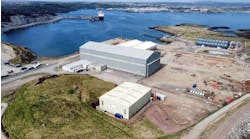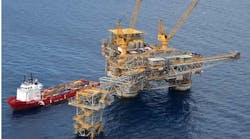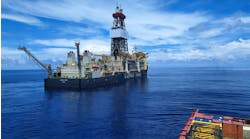In early 1997 Balder, which yielded Norway's first offshore oil, is finally due to come into production. Its development is the result of recent strides in improving the economics of
Norway's offshore projects. Norway's first oil emerged from the wellhead in a production test on exploration well 25/11-1 which was drilled into the northern part of Balder in 1967. It took a further seven years before the potential commerciality of the field was established. Balder, which is 100% owned by Esso, is a very complex field, consisting of relatively heavy oil in unconsolidated sandstone, contained in eleven separate mounds.
A total of 19 wells has so far been drilled on it. Previous attempts to find an economic form of development had proved abortive. A period of test production in 1991, using the Petrojarl 1 production ship, helped to answer a lot of questions, Esso says. With the use of gel, cores were successfully retrieved from the reservoir.
But it was only in 1995 that Esso finally found a solution, and a fast-track one at that, in the shape of Smedvig's SPU 380 production ship. It will pay about $295 million for the vessel, which will become the first FPSO installed in Norwegian waters. If the production ship in the North Sea is very much a 1990s concept, so too, is the collaborative relationship between Esso and its development contractors. Smedvig is particularly closely involved, both in the development team and also as part of the joint production team. It will also carry out development drilling, for which it has mobilized the West Alpha semisub from the Far East. The rig is due to start work in April.
Meanwhile overall responsibility for supplying and installing the subsea equipment has been contracted to ABB Offshore Technology, assisted by Coflexip Stena. Capital costs, including the vessel purchase, are about NKr 4.7 billion.
The first phase of development involves the production of some 170 MMbbl from six of the mounds. This will call for 15 subsea wells - 10 producers, three water injectors, one gas injector and one water source well, which will be used for the re-injection of produced water. The production vessel will be able to produce 75,000 b/d of oil and store 380,000 bbl. It is due at a Sandnes yard this spring for outfitting, and will be installed on the field in autumn.
Production from the remaining mounds, which hold about another 50 MMbbl, is likely to follow at a later stage, and could involve a further 11 wells.
The NKr 700 million EPCI contract for the subsea part of the Balder development represents an important reference for ABB Offshore Technology in its role as a turnkey contractor. The equipment which the company will supply - subsea trees and wellheads, flowlines, risers and umbilicals, and control systems - is worth some NKr 400 million. "Some 70-80% of the value-added is contributed by ABB," says managing director Bjoern Ove Skjeie. "This is quite an achievement - there are few other contractors in the same league."
And in a country which takes turnkey contracts seriously, scope of supply is a key selling point. As Skjeie says of the Balder award: "We were competitive on price, and made a good commitment on schedule. But we also scored points on exactly the fact that we control so much of the scope."
ABB has recently extended the range of its in-house services with the acquisition of the subsea control system business of GEC Marconi. In a company dedicated to the defense industry, the subsea controls division was left out on a limb. Now renamed ABB Seatec, it will benefit from becoming a part of a real oil and gas player, says Skjeie. The new company will play a central role in ABB's project to develop a new generation of subsea control systems. This will be an all electric system, as opposed to the hydraulic and electro-hydraulic systems in current usage. Previously ABB's access to subsea control system capability was through a part-interest held by ABB Vetco Gray in FSSL, but this stake has now been sold.
As well as ABB Seatec, other ABB companies which will contribute to Balder include ABB Vetco Gray for the subsea trees and wellheads, and Maritime Seanor, part of the Maritime Group, in which ABB owns 40%, for the protection structures.
ABB's partner on the Balder contract is Coflexip Stena Offshore, which is responsible for the installation of the subsea equipment and flowlines, and will also supply the umbilicals through its Duco subsidiary. CSO's part of the contract is worth about NKr 300 million.
ABB and CSO know each other well through their work on a number of Saga developments. This began with the Tordis project in 1993-94, and has continued with the Vigdis and Tordis East projects, which are both due to come on stream next year.
Another important success for ABB is its inclusion in the integrated team, alongside Aker Engineering and Maritime Tentech, which is to supply the Aasgard oil production ship. Previously, when contractors were invited to submit ideas, ABB proposed a shipshape facility for Aasgard oil and a big semisub for the gas. These concepts have since been selected for the development by the joint operators Statoil and Saga.
Copyright 1996 Offshore. All Rights Reserved.


